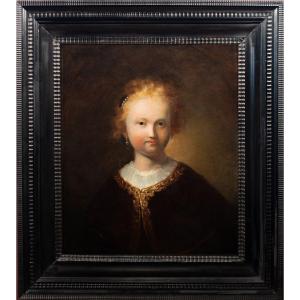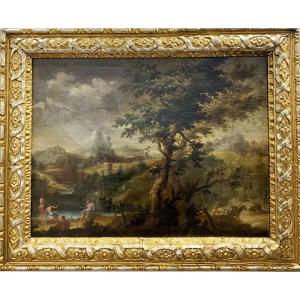Presented in their original frames in gilded, molded and carved wood (Salvator Rosa model)
Dimensions with frame: 60 x 75 cm. Copper only: 40 x 57 cm
This pair of exquisite and elaborate landscapes, with superb blue dominants are true masterpieces of Cimarolian realism and are among the finest views created by the Lombard painter at the beginning of his career. One can clearly recognize the distinctive characteristics of Venetian painting of the early 18th century, as it developed with Marco Ricci, Giuseppe Zais and Francesco Zuccarelli. Using a meticulous brushwork, he describes the daily life of his contemporaries in a way that is both realistic and borrowed from great gentleness. In our two paintings we find a misty atmosphere, from which a mountain range stands out in the distance closing the composition above large lakes (these large lakes of Northern Italy). A whole life "teems", the groups of shepherds in the foreground leading their flocks, the fishermen hauling in the nets and the classical residences of Venetian architecture are carefully described. Just like the boats on the water reflecting a slightly orange sky. This chromatic construction appears in a number of Cimaroli's landscapes, especially in his early works, as well documented in the monograph dedicated to the painter by Francesca Spadotto (Giovan Battista Cimaroli, Rovigo 2011, nos. 5 and 5a, 15 and 15a).
*Biography
Giovanni Battista Cimaroli was born in Salò in 1687 on Lake Garda, near Brescia, son of Girolamo and Angela Magnanine. He began studying painting at the school of Antonio Aureggio in Brescia and in Bologna in the studio of Antonio Calza, a well-known landscape and battle painter, of whom Cimaroli would become the brother-in-law: Cimaroli is said to have married the sister of Calza's third wife, Angiolà Agnese Pakman, herself known as a painter of flowers, fruits and animals. Cimaroli's wife, whose name is unknown, also devoted herself to this type of painting. Cimaroli moved to Venice around 1713. From 1722, and even a little before, Cimaroli established a relationship with Canaletto, who was ten years his junior, but already renowned, and he became one of his collaborators. They worked together in particular on the creation of several canvases representing the allegorical tombs of illustrious figures, a series commissioned by Owen Mc Swiney on behalf of the Duke of Richmond. In Venice, Cimaroli made a name for himself. The vedutism practiced in particular by Caneletto became a source of inspiration for Cimaroli; he also produced topographical views of Venice. And he became a very prominent painter and received numerous commissions.
Provenance: Private collection, Rome.
Related work: Pair of landscapes by Cimaroli Christie's London sale 14/12/2006 (Lot: 25)
Sold with an expert certificate















































 Le Magazine de PROANTIC
Le Magazine de PROANTIC TRÉSORS Magazine
TRÉSORS Magazine Rivista Artiquariato
Rivista Artiquariato